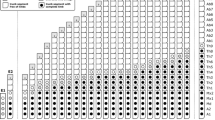Summary
Morphogenesis of the carotid labyrinth inRana catesbeiana during larval development and metamorphosis was studied using vascular corrosion casting and scanning electron microscopy. The carotid labyrinth was formed at the point where the carotid arch descends to the internal gills. The transformation of the appearance of the carotid labyrinth can be summarized in six phases. 1. Through the early stages of larval development (stages I–V), the slightly expanded region of the external carotid artery becomes closely connected with the carotid arch, and these two arteries are joined by small channels on their opposing faces. 2. By the last stage of foot stages (stage XVII), the expanded region becomes globular. 3. At the middle of the metamorphic stages (stage XXII), many protuberances appear on the surface of the globular expansion. 4. At stage XXIII, these form a rudimentary vascular maze. 5. At stage XXIV, this globular expansion is completely surrounded by a simple maze-like structure that resembles the carotid labyrinth in adults. The origin of the internal carotid artery is located within the vascular maze. 6. At the final stage of metamorphosis (stage XXV) the carotid labyrinth is nearly completed. The vascular ring and vascular routes found in the adult can be recognized at the proximal and distal end of the labyrinth, respectively. These findings suggest that the premetamorphic carotid labyrinth has a vascular regulatory function.
Similar content being viewed by others
References
Adams WE (1958) The comparative morphology of the carotid body and carotid sinus. Thomas, Springfield, Ill. pp 202–214
Boissezon P (1939) Le labyrinthe carotidien de la grenouille rousse adulte. Bull Soc Hist Nat Toulouse 73:145–152. In: Carman JB (ed) The carotid labyrinth inHyla aurea, with a note on that inLeiopelma hochstetteri. J Anat 89:503–525
Cannatella DC, Treub L (1988) Evolution of pipoid frogs: intergeneric relationships of the aquatic frog family Pipidae (Anura). Zool J Linn Soc 94:1–38
Carman JB (1955) The carotid labyrinth in Hyla aurea, with a note on that inLeiopelma hochstettri. J Anat 89:503–525
Carman JB (1967a) The carotid labyrinth in the anuranBreviceps mossambicus. Trans R Soc N Z Zool 10:1–15
Carman JB (1967b) The morphology of the carotid labyrinth inBufo bufo andLeiopelma hochstetteri. Trans R Soc N Z Zool 10:71–76
Ishida S (1954) So-called carotic body of the amphibia. Igaku Kenkyu (Fukuoka) 24:1024–1050
Ishii K, Kusakabe T (1982) The glomus cell of the carotid labyrinth ofXenopus laevis. Cell Tissue Res 224:459–463
Ishii K, Oosaki T (1969) Fine structure of the chemoreceptor cell in the amphibian carotid labyrinth. J Anat 104:263–280
Ishii K, Honda K, Ishii K (1966) The function of the carotid labyrinth in the toad. Tohoku J Exp Med 88:103–116
Kobayashi S, Murakami T (1975) Scanning electron microscopic observation of the fine three-dimensional distribution of the blood vessels in the frog carotid labyrinth. In: Purves MJ (ed) The peripheral chemoreceptors. Cambridge University Press, Cambridge, pp 301–313
Kusakabe T (1990a) Ultrastructural studies of the carotid labyrinth in the newtCynops pyrrhogaster. Zool Sci 7:201–208
Kusakabe T (1990b) Comparative studies on the vascular organization of carotid labyrinths of anurans and caudates. J Morphol 204:47–55
Kusakabe T, Ishii K, Ishii K (1987) A possible role of the glomus cell in controlling vascular tone of the carotid labyrinth ofXenopus laevis. Tohoku J Exp Med 151:395–408
Mishima D (1944a) On the development of the carotid gland of anurans. I. InRhacophorous arborea schlegelli. Kaibogaku Zasshi 22:339–347
Mishima D (1944b) On the development of the carotid gland of anurans. II. InBufo formosus. Kaibogaku Zasshi 22:399–408
Noguchi R, Kobayashi S (1977) On the vascular architecture of the carotid labyrinth inCynops pyrrhogaster andOnychodacty-lus japonicus. Arch Histol Jpn 40:347–360
Pischinger A (1934) Über die Entwicklung und das Wesen des Carotislabyrinths bei Anuren. Z Anat Entwicklungsgesch 103:45–52
Poullet-Krieger M (1973) Innervation du labyrinthe carotidien du crapaudBufo bufo: etude ultrastructurale et histochimique. J Microsc (Paris) 18:55–64
Rogers DC (1963) Distinct cell types in the carotid labyrinth. Nature 200:492–493
Taylor AC, Kollros JJ (1946) Stages in the normal development ofRana pipiens larvae. Anat Rec 94:7–23
Toews D, Shelton G, Boutilier R (1982) The amphibian carotid labyrinth: some anatomical and physiological relationships. Can J Zool 60:1153–1160
Author information
Authors and Affiliations
Rights and permissions
About this article
Cite this article
Kusakabe, T. Morphogenesis of the carotid labyrinth in the bullfrog,Rana catesbeinna, during larval development and metamorphosis. Anat Embryol 184, 133–139 (1991). https://doi.org/10.1007/BF00942744
Accepted:
Issue Date:
DOI: https://doi.org/10.1007/BF00942744




